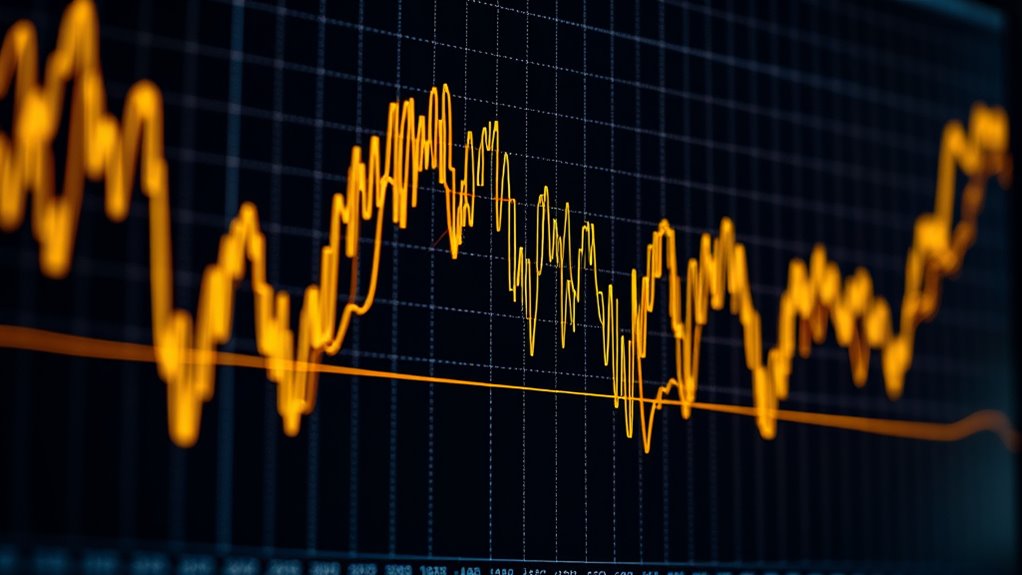To interpret the 80-year gold-silver ratio chart like a technician, focus on identifying long-term trends, support and resistance levels, and key chart patterns such as head and shoulders or double tops and bottoms. Use moving average crossovers to spot buy or sell signals, and watch for deviations caused by market anomalies or external events. By analyzing these indicators within broader economic contexts, you can develop clearer investment insights—exploring further reveals how to refine this approach.
Key Takeaways
- Identify long-term support and resistance levels to signal potential reversals or trend continuations in the ratio.
- Use moving average crossovers to generate buy or sell signals based on trend shifts.
- Recognize chart patterns like head and shoulders or double tops/bottoms for predictive insights.
- Analyze historical trend lines to assess market sentiment and possible inflection points.
- Combine technical signals with fundamental context for more accurate timing and risk management.

The gold-silver ratio is a crucial tool for investors seeking to understand the relative value of these precious metals. It tells you how many ounces of silver are needed to buy one ounce of gold. To calculate it, simply divide the current price of gold by the current price of silver. This ratio is more than just a number; it reflects market sentiment and investor expectations and provides insight into the historical and current relationship between these metals. Historically, the ratio has varied widely, with ancient civilizations like Rome using fixed ratios such as 12:1. In the 19th century, the US maintained a 15:1 ratio under the bimetallic standard. Since abandoning the gold standard, the ratio has fluctuated based on supply and demand, often rising during times of economic uncertainty. Since February 2013, it has remained elevated above 60:1, frequently exceeding 80:1, and during turbulent times, it can surpass 100:1.
Market influences play a significant role in the ratio’s movements. When economic uncertainty ramps up, the ratio tends to climb, as investors flock to gold as a safe haven. Silver’s industrial demand also impacts its price, influencing the ratio’s direction. Market sentiment, driven by geopolitical events, inflation expectations, or financial crises, can cause sharp fluctuations. During periods of market volatility, investors might buy gold aggressively, pushing the ratio higher. Conversely, when silver’s industrial uses surge or demand increases, the ratio may decline. Understanding these influences helps you interpret whether the current ratio signals a buying or selling opportunity.
As a technician, you can use the 80-year chart of the gold-silver ratio to identify trends and potential turning points. Trends in the ratio reveal whether the market favors gold or silver at any given time. Support and resistance levels on the chart help you pinpoint when the ratio might reverse or accelerate. Crossovers of moving averages can act as buy or sell signals, indicating shifts in market momentum. Recognizing chart patterns, such as head and shoulders or double tops and bottoms, further enhances your ability to predict future movements. The relative strength of gold versus silver, seen through these technical signals, guides your strategic decisions. Additionally, observing long-term supply and demand dynamics can improve your understanding of potential reversals or sustain trends. Recognizing market anomalies, like the 1980 ratio narrowing to around 15:1 during the Hunt brothers’ silver market corner, or the 2011 tightening to about 31:1 amid quantitative easing, remind you that external factors can cause dramatic deviations from typical ranges. These anomalies serve as lessons on how market events influence the ratio, emphasizing the importance of technical analysis in steering through these fluctuations. Furthermore, incorporating market sentiment analysis can provide additional context for interpreting these technical signals. Moreover, paying attention to fundamental factors such as global economic outlooks and monetary policies can provide further context for interpreting the chart signals. Additionally, understanding the impact of supply and demand dynamics over the long term can help you anticipate potential reversals or continuations in the trend. By studying the long-term chart, you can better time your entries and exits, manage risk, and capitalize on relative value shifts between gold and silver.
Frequently Asked Questions
How Does Inflation Impact the Gold-Silver Ratio?
Inflation impacts the gold-silver ratio by boosting silver‘s performance more than gold’s, since silver is both an industrial metal and a hedge against rising prices. When inflation rises, demand for silver increases due to its industrial uses and its role as an inflation hedge, causing its price to outpace gold. This leads to a lower ratio, signaling silver’s stronger relative performance during inflationary periods.
Can Geopolitical Events Influence the Ratio’s Signals?
You should know that geopolitical events can definitely influence the gold-silver ratio signals. When tensions rise, gold often gains as a safe haven, causing the ratio to widen. Silver’s industrial demand and supply chain issues also matter; disruptions may lower silver prices relative to gold, further increasing the ratio. Keep an eye on geopolitical developments, as they can trigger quick, significant shifts in the ratio’s direction.
What Are the Limitations of Using Long-Term Charts?
Long-term charts have their limitations. You might miss short-term opportunities because these charts smooth out volatility and respond slowly to sudden market changes. They can oversimplify complex data, leading to subjective interpretations. Additionally, focusing solely on long-term trends could cause you to overlook important fundamentals and recent events. To get a complete picture, you need to combine these charts with other analysis tools and stay aware of their inherent delays and biases.
How Often Should Traders Revisit the Ratio Signals?
Imagine holding the key to market insight—how often should you revisit ratio signals? You should monitor them daily if you want quick turns, but weekly or monthly reviews help spot broader trends. Quarterly or annual checks provide long-term perspective. Regularly revisiting these signals keeps you alert and ready, like a sailor reading the stars, steering market volatility with confidence and precision.
Are There Other Commodities That Correlate With Gold and Silver?
You might wonder if other commodities correlate with gold and silver. Copper stands out because of its strong correlation with silver, driven by industrial uses and supply links. While gold doesn’t have a strong connection with other base metals, it often moves independently, influenced more by macroeconomic factors. Keep an eye on commodities like copper and industrial metals, as their movements can sometimes hint at trends in precious metals.
Conclusion
By understanding the gold-silver ratio chart like a seasoned navigator, you hold the compass to future trends. Think of the ratio as a lighthouse, guiding your decisions through the fog of market fluctuations. When you interpret these signals wisely, you’re steering your investments away from hidden reefs and toward safe harbors. Embrace this chart as your map—trust its symbols, and let it illuminate your path to smarter, more confident trades.









